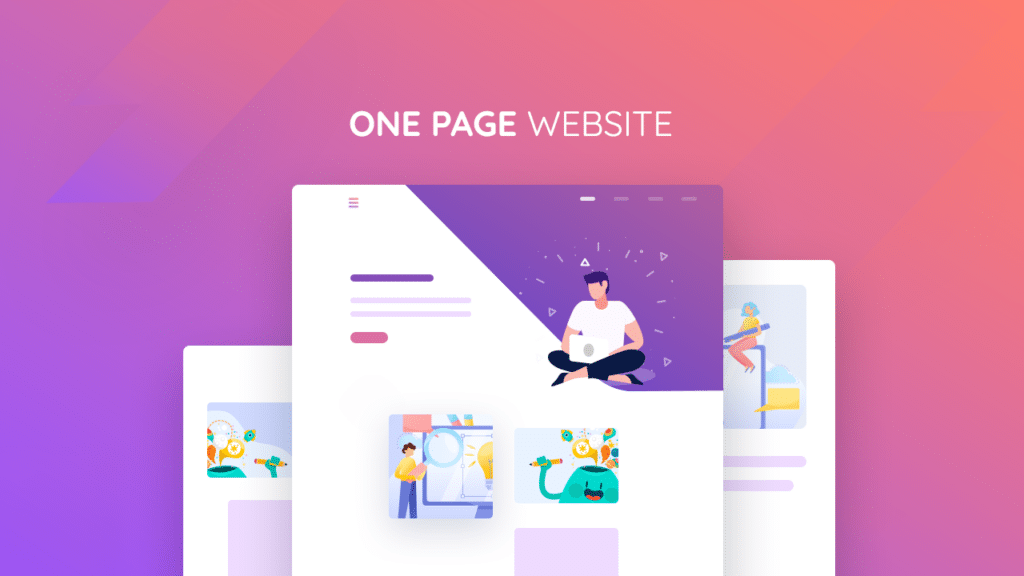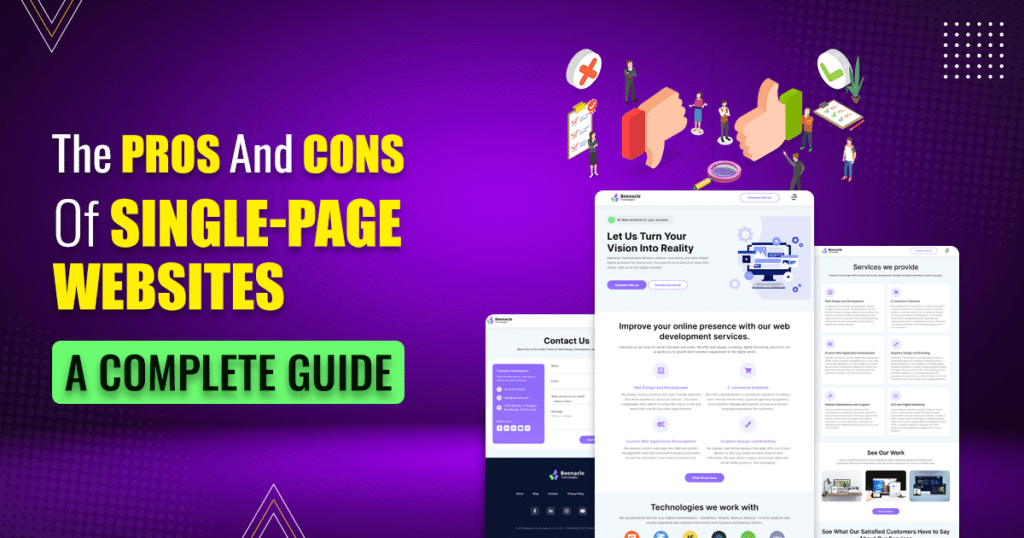Table of Contents
Single-page websites are websites that have only one HTML page, where all the content is displayed in different sections that are linked by the menu navigation. Single-page websites are becoming more popular, especially for landing pages, portfolios, events, or special projects. But are they suitable for every purpose? In this blog post, we will explore the pros and cons of single-page websites, and help you decide if they are right for your web design and development needs.
What are single-page websites?

A single-page website or one-pager is a website that has only one HTML page. Unlike a multi-page website where the menu navigation items link to other single pages on the website, menu items on a single-page website link to different sections of the page.
If you’re looking for some inspiration and examples of single-page websites, here are some websites that I recommend you check out:
- Awwwards: Single Page Websites: A collection of award-winning single-page websites with different design, creativity, and usability features.
- Wix: 20 Beautiful One-Page Websites to Inspire You: 20 examples of beautiful and effective single-page websites created with Wix, a website builder platform.
- One Page Love: A showcase of the best one-page websites from around the web, with reviews and feedback from the website’s creator, Rob Hope.
Single-page websites can have different designs and layouts, depending on the goal and content of the website. Some common elements of single-page websites are:
- A hero section with a catchy headline and a call-to-action (CTA) button
- A navigation menu that links to different sections of the page
- A features or benefits section that highlights the value proposition of the website
- A testimonials or social proof section that showcases customer reviews or ratings
- A gallery or portfolio section that displays images or videos of the work or products
- A contact or footer section that provides contact details or social media links
The Pros of Single-Page Websites
Single-page websites have many advantages, such as:
- Simplicity: Single-page websites are easy to create, maintain, and update. You don’t need to worry about multiple pages, links, or navigation. You can focus on creating a clear and concise message that captures your audience’s attention and guides them to your desired action.
- User experience: Single-page websites provide a smooth and seamless user experience, as there is no need to reload the page or wait for new pages to load. Users can scroll or click through the different sections of the page, and enjoy the interactive elements, such as animations, transitions, or parallax effects. Single-page websites are also responsive and mobile-friendly, which is essential for today’s web users.
- Conversion rate: Single-page websites can increase your conversion rate, as they eliminate distractions and keep users focused on your offer or goal. You can create a compelling story that leads users to your call-to-action (CTA), whether it is to sign up, buy, contact, or download. You can also use social proof, testimonials, or statistics to boost your credibility and trustworthiness.
The Cons of Single-Page Websites
Single-page websites also have some drawbacks, such as:
- SEO: Single-page websites can be challenging to optimize for search engines, as they have limited content, keywords, and meta tags. You also have only one URL to rank for, which means you can’t target different keywords or topics with different pages. You may need to use other strategies, such as blogging, social media, or paid ads, to drive traffic to your single-page website.
- Performance: Single-page websites can affect your website’s performance, as they load all the content and media at once. This can result in longer loading times, especially if you have large images, videos, or animations. You may need to optimize your images, use lazy loading, or compress your files to improve your website’s speed and performance.
- Scalability: Single-page websites can limit your website’s scalability, as they are not suitable for complex or large-scale projects. If you have a lot of content or information to share with your audience, a single-page website may not be enough. You may need to use multiple pages to organize your content better and provide more value to your users.
How to create a one-page website
If you decide to create a single-page website, you have two main options: DIY or custom code.
DIY
The easiest way to build a single-page website is using a website builder such as PageCloud, Wix, or Squarespace. These website builders allow you to create a single-page website without any coding or design skills. You can choose from hundreds of templates, customize them with drag-and-drop tools, and add your own content and media.
Some benefits of using a website builder are:
- You can save time and money, as you don’t need to hire a professional designer or developer
- You can have full control over your website, as you can edit and update it anytime and anywhere
- You can get access to various features and integrations, such as hosting, domain, analytics, SEO, ecommerce, etc.
Some drawbacks of using a website builder are:
- You may have limited customization options, as you have to work within the constraints of the template and the platform.
- You may have less flexibility and security, as you have to rely on the platform’s performance and policies.
- You may have less uniqueness and originality, as your website may look similar to other websites using the same template or platform.
Custom code
The other way to build a single-page website is using custom code. This means hiring a professional designer or developer, or doing it yourself if you have the skills and knowledge. You can use various frameworks, content management systems (CMS), or code editors to create a single-page website from scratch.
Some benefits of using custom code are:
- You can have unlimited customization options, as you can create any design or layout you want
- You can have more flexibility and security, as you can choose your own hosting, domain, and tools
- You can have more uniqueness and originality, as your website will be one-of-a-kind
Some drawbacks of using custom code are:
- You may have to spend more time and money, as you have to hire a professional or learn how to code.
- You may have less control over your website, as you may need technical assistance or maintenance.
- You may have more complexity and difficulty, as you have to deal with coding errors or issues.
Conclusion
Single-page websites are not for everyone. They have their pros and cons, depending on your web design and development goals and needs. Before you decide to create a single-page website, you should consider the following questions:
- What is the purpose of your website?
- Who is your target audience?
- What is the message you want to convey?
- What is the action you want users to take?
- How much content do you have?
- How do you plan to drive traffic to your website?
If you are looking for a professional and reliable web development agency that can create a stunning single-page website for you, look no further than Beenacle Technologies. We have the skills and experience to create a single-page website that showcases your brand, improves your conversion rate, and maximizes your revenue. Whether you need a simple or complex website, we can create it for you. Get in touch with us today to get a free consultation and quote for your web design and development project.
